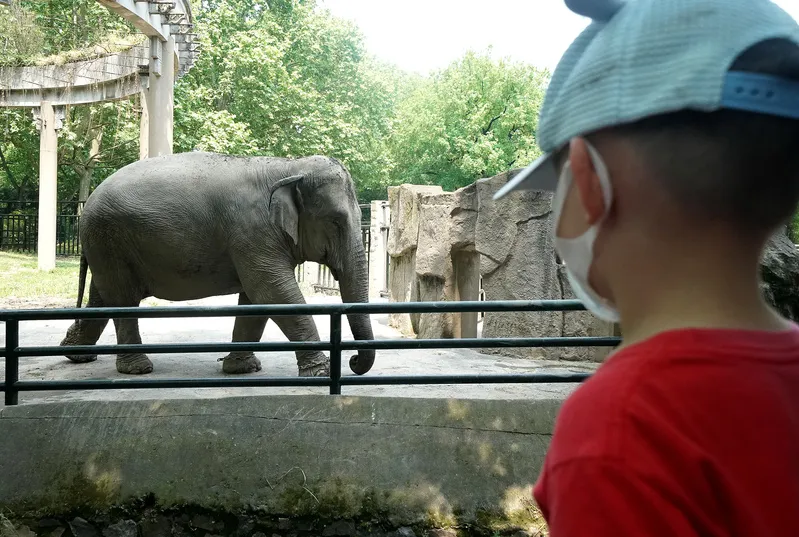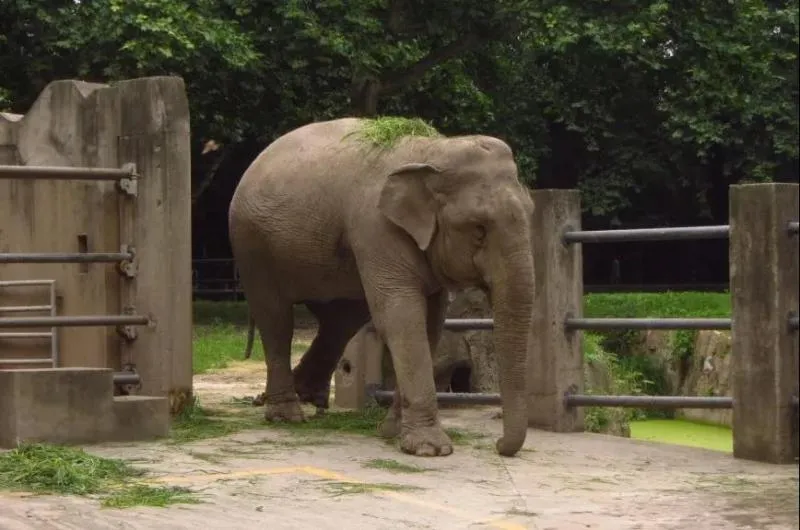An old friend "came back" with his children. At this birthday party, he has been with Shanghainese for 46 years.
On May 25, 1954, Shanghai Xijiao Park was opened to the public. In September of the same year, the Shanghai Municipal Government decided to expand Xijiao Park into a zoo. On New Year's Day in 1980, Xijiao Park was renamed Shanghai Zoo, but old Shanghai still used to call it "Xijiao Park".
Since its establishment, the Shanghai Zoo has received a total of 230 million visitors, becoming an important part of the beautiful memories of generations of Shanghainese.
On May 30, 2024, the Shanghai Zoo celebrated its 70-year-old birthday in a special and heartwarming way - the scene of the Asian elephant "Banna" and its two children "Mina" and "Kangkang" taking a pleasant walk was cast It is a bronze sculpture and is located in the Elephant Palace Square.
Asian elephant "Banna" and her two children "Mina" and "Kangkang". Photographed by Chen Xishan
"An old friend is back with his child!" Zhu Rongjiang, deputy director of the herbivorous area of Shanghai Zoo, said emotionally while stroking a stubby wrinkle on "Banna"'s nose. Under the guidance of the senior keeper Xu Jianhua, he accompanied "Banna" "After completing the last two years of "Xiang Sheng": "Everyone at the zoo has put their heart and soul into this sculpture. Some old keepers specially found old photos and video materials, and repeatedly told the craftsmen to restore 'Banna' when he was in his prime. The most beautiful body and charm.”
Zhu Rongjiang told reporters that the special wrinkles on the nose were changed at the request of the seniors. They lived with "Banna" day and night, and every small feature was engraved in their minds.
Looking at zoos across the country, it is very rare for Asian elephants to be given such courtesy. The Shanghai Zoo celebrated its birthday with the unveiling of an elephant sculpture precisely because the Shanghai Zoo has an indissoluble bond with Asian elephants. To put it more bluntly, the Shanghai Zoo was born because of the elephants.
The Shanghai Zoo can be traced back to the old Yutai stable owned by British expatriate Barnes Dallas, which opened in 1900 and covers an area of 13,300 square meters. It was later bought by eight British businessmen and a golf course club was established in 1916. By 1920, the area expanded to 278,000 square meters.
In 1953, the Shanghai Municipal Government funded the recovery of the golf course and related facilities and invested 853,300 yuan to build it into a cultural park. On May 25, 1954, Xijiao Park opened. In the first 10 days of its opening, there were huge crowds of people, with the largest number of visitors reaching 150,000 on the day.
Just when everything was on track, an elephant changed the fate of the western suburbs park. In June 1954, the General Office of the State Council notified the Shanghai Municipal Government that the elephant "Nanjiao" dedicated to Chairman Mao by the Dai people in Xishuangbanna was handed over to Shanghai for breeding and display.

After expert surveys, it was decided to build the Xijiao Park into a zoo integrating exhibition, production, scientific research and popular science in phases to prepare for the welcome of "Nanjiao".
In December 1954, seven scientific and technological personnel and breeders went to Xishuangbanna for inspection. After untold hardships, in June 1955, they escorted "Nanjiao" and more than 20 other animals from Yunnan and Guizhou to Shanghai. On July 9, 1955, the animal exhibition area of Xijiao Park was opened. The exhibition area is about 40,000 square meters, accounting for 10% of the total area of the park. There are 46 animals of 31 species on display. Tickets are 5 cents each.
At the Shanghai Zoo, children carefully observe elephants.
Born because of elephants, this is clearly reflected in the main entrance of Shanghai Zoo. Photo courtesy of Shanghai Zoo
After "Nan Jiao" arrived in Shanghai, Vietnam sent another female elephant "A Bang", and the two female elephants lived together.
At that time, no one thought that the third female elephant that was about to be welcomed into the Shanghai Zoo would become a good friend of generations of Shanghainese. People have a deeper affection for her than "Nan Jiao", the "originator of the zoo".
In 1971, the Shanghai Zoo obtained the consent of the competent national authorities and sent personnel to patrol the deep mountains and dense forests of Xishuangbanna to hunt wild elephants. The popular color documentary "Elephant Catching" in 1972 recorded the dangerous and thrilling process at that time.
"Banna" is part of an elephant herd led by a female elephant. There are more than 20 wild elephants in this elephant herd. When she was captured, "Banna" was 7 years old, weighed about 1.5 tons, and was still a "little girl."
In May 1972, after a long journey, "Banna" settled in the Shanghai Zoo. In 1974, "Banna" fell in love for the first time, and fell in love at first sight with "Bamo" from the Beijing Zoo, who was two years older than him. In September 1976, "Banna" became pregnant and gave birth to the first daughter "Yina" on June 14, 1978.
"Banna" and "Bamo" are a model couple, very loving, and have raised eight children together, setting a record for the largest number of Asian elephants breeding in a Chinese zoo. In captivity, female elephants typically give birth to only three to four calves in their lifetime.

"Banna"'s second daughter "Erna" also successfully gave birth to second-generation Asian elephants "Lina" and "Yuanyuan", making "Banna" a grandmother.
"'Banna' is a great mother who gives all her love to her children, but neglects her own health." Zhu Rongjiang recalled that after "Banna" gave birth to her first child in 1978, she no longer slept on the floor and developed the habit of standing. The habit of resting against the wall was originally to protect the children day and night. Standing for 40 years caused chronic damage to the joints and soles of the feet. In his later years, he was tortured by symptoms such as swelling, lameness, and suppuration.
On August 7, 2017, due to old age, frailty and long-term foot disease, the 53-year-old "Banna" couldn't bear the continuous high temperature and fell to the ground. Although he was rescued, "Banna" tenaciously stood up again, but he had no choice but to run out of oil and died at 12:50 on November 25, 2018 due to ineffective treatment. He was 54 years old.
"The old friend we spent time with day and night passed away, and everyone cried. We regretted it at that time. We should work harder and try to guide 'Banna' to change the bad habit of standing for long periods of time, so that it will not be so painful in his later years." Zhu Rongjiang said, Nowadays, the elephant house is filled with various toys that elephants love, allowing them to unleash their natural instincts and increase their activity. At the same time, the sandpit and tires placed against the wall are well-designed "sofa beds" that are deeply loved by the elephants. The new hostess "Duo Duo" loves it.
Healthy "Banna". Photo courtesy of Shanghai Zoo
The loving "Banna" and "Bamo". Photo courtesy of Shanghai Zoo
Reminiscing about old friends, the 70-year-old Shanghai Zoo also looks forward to a new future.
With the progress of society, zoos are no longer just places to entertain the public, but have begun to assume more missions and tasks. They adhere to the concept of animal-oriented conservation, use more scientific and rigorous methods to conserve animals, and provide a better environment for biological life in China and around the world. Diversity goes all out.
With advanced breeding techniques, the days of capturing wild animals in the wild and keeping them in captivity in zoos are over. Since its establishment, Shanghai Zoo has successfully bred more than 240 species of wild animals, among which nearly 50 species including Oriental white storks, alligators, and red gorals have been bred for the first time in China. In recent years, the number of animal breeding species in Shanghai Zoo has maintained at more than 70 species every year.
The Shanghai Zoo is currently the only zoo in China that has successfully bred the four great apes, namely gorillas, orangutans, chimpanzees, and gibbons, and has contributed to the development of China’s captive populations of endangered wild animals and the protection of the genetic diversity of endangered species.

In this regard, Shi Xinquan, the old director of Shanghai Zoo, is full of pride: "At that time, only the zoos in Beijing and Jinan had gorillas in the country. We impressed the European zoos with our sincerity and technology, and finally welcomed 'Boroman', which became a hot favorite in Shanghai Zoo. 's big star.
A few years later, the Shanghai Zoo successfully passed the inspection by the International Animal Protection Organization and welcomed a male gorilla and two female gorillas, which became the foundation of the gorilla population of the Shanghai Zoo today.
The latest statistics show that the animal population of Shanghai Zoo has grown to more than 460 species and more than 5,000 animals, including nearly 70 species of first-level protected animals and nearly 200 species of second-level protected animals, covering everything from fish to mammals, from domestic to More than 50 dominant populations of major representative species in different regions of the world have been established, including South China tigers, chimpanzees, spotted-billed penguins, golden monkeys, orangutans, gorillas, and giraffes.
The Shanghai Zoo's first-of-its-kind native animal area simulates the natural environment of Shanghai and surrounding areas, focusing on displaying native animals around Shanghai to attract citizens to learn more about and pay attention to the protection of native animals.
On May 30, 12 units including Shanghai Zoo and Nanjing Hongshan Forest Zoo also signed a convention to establish the Yangtze River Delta Zoo Alliance to deepen cooperation and exchanges in comprehensive wildlife protection, natural education, scientific research and other aspects.
The "old masters" rushed to the scene to celebrate the birthday of Shanghai Zoo. Photographed by Chen Xishan
The Yangtze River Delta Zoo Alliance was established. Photo courtesy of Shanghai Zoo





